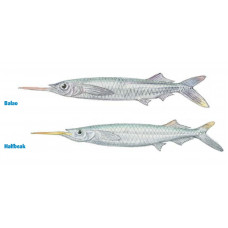Latin name
Hemiramphus balao and Hyporhamphus unifasciatus
Other names
French: demi-bec; Spanish: aguja, agujeta, saltador.
Identification
The body is elongated, rounded, and flattened laterally only in the tail area. The dorsal and anal fins are far back and directly opposite each other. Only the lower jaw is long, the upper jaw is of normal length. These fish usually jump or move quickly on the surface, with only their tail vibrating in the water.
Distribution
Halfbeaks (Hemiramphus balao) inhabit from New York to the Gulf of Mexico and south to Brazil, including the Caribbean. Balao (Hemiramphus brasiliensis) is common off the coast of Florida and in the Caribbean, and in summer moves north along the east coast and sometimes north to Massachusetts. It inhabits as far south as Brazil.
Habitat
These sparkling, silvery fish move in whole flocks and are numerous in warm seas.
Size
Hemiramphus brasiliensis has an average length of 6 to 10 inches and is closely related to the Pacific long-finned ballyhoo (H. saltator). Hyporhamphus unifasciatus, which reaches 12 inches, is found in the same area of the Atlantic as ballyhoo, but is also found in the Pacific Ocean from Point Conception south to Peru, including the Galápagos Islands. The related California halfbeak (H. rosae) is smaller, rarely exceeding 6 inches in length. Pacific halfbeaks off the coast of North America include the ribbon halfbeak (Euleptorhamphus viridis), which grows to 18 inches and also has long pectoral fins, and the smaller flying halfbeak (E. velox), which lives from the Gulf of Mexico to Brazil in the western Atlantic Ocean.
Life history and Behavior
No information
Food and feeding habits
It is an important food fish for pelagic species, especially billfish, and are used as trolling bait for big fish found in blue water.
Reproduction
No information
| Classification | |
| Phylum | Chordata |
| Class | Actinopterygii |
| Squad | Beloniformes |
| Family | Hemiramphidae |
| Genus | Hemiramphus |
| Species | Hemiramphus balao |
| Features | |
| Conservation status | Least Concern |
| Habitat | Littoral |
| Life span, years | No information |
| Maximum body weight, kg | No information |
| Maximum length, cm | 40 |
| Sailing speed, m/s | No information |
| Threat to people | Edible |
| Way of eating | Planktonophage |
Halfbeaks and Balao
Tags: Halfbeaks and Balao

